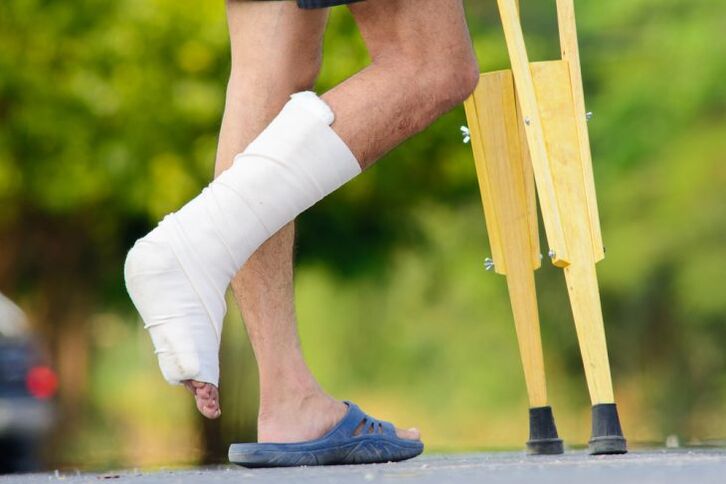Deformed joints most commonly affect lower extremity joints, one of which is the ankle. These joints have a lot of mobility in different planes and play an important role in walking (rolling the foot and transferring weight from the heel to the toes), while also carrying the body's weight. Ankle arthropathy is a retribution for walking upright. But many other factors play a role in the development of the disease. First, for the patient, unknowingly, the articular cartilage coating begins to soften and thin before breaking down, triggering an inflammatory process and the growth of bone tissue in the form of osteophytes. With advanced arthropathy, a person is unable to move without support and experiences severe pain, especially when leaning on the leg. Without early comprehensive treatment, disability may develop within a few years of the onset.
Cause of disease development

Previous injuries to the ankle joint increase the likelihood of degenerative processes occurring within it.
- weight gain;
- Flat feet, congenital foot deformities (equinus, clubfoot);
- Metabolic disorders in diseases such as diabetes, gout, and atherosclerosis of blood vessels in the legs;
- past joint injuries, such as ligament damage, ankle fractures, and foot bones;
- Continued overloading of the joints, leading to microtrauma (athletes and weight-bearers);
- Genetic susceptibility to joint arthropathy;
- Inflammation of joints (arthritis) in infectious or systemic diseases (rheumatoid, psoriasis, gouty arthritis).
Ankle joints can be primary or secondary, depending on the presence or absence of specific factors that contribute to the disease. There are also stages. In the presence of the first stage, a person is able to work, if the arthropathy has advanced into the second and third stages, pain and limited mobility resulting in disability (temporary or complete).
Symptoms of Ankle Osteoarthritis
- The pain of "starting". This is one of the early symptoms of ankle osteoarthritis. Pain when trying to lean on the leg after sitting for a long time may be accompanied by short-term stiffness of the joint movement. After a few steps, the pain disappeared;
- pain during and after physical exertion;
- Pain at night, which is associated with inflammatory processes due to the destruction of cartilage tissue;
- Tightening, the clicking of the joints during movement;
- puffiness, especially under the ankles;
- restrict movement;
- Atrophy of muscles around joints and weakness of ligamentous organs as a person begins to relieve pain in the legs;
- Joint deformities in the end stage of arthropathy.
diagnosis
It is necessary to distinguish arthropathy and its deterioration from various inflammatory processes in the joints, for example, due to rheumatoid gout or psoriatic arthritis. Therefore, the doctor prescribes a detailed blood test, rheumatoid test, CRP, uric acid test. For arthropathy, these markers are normal, but if the disease is in the acute phase, ESR and white blood cells may be elevated. To determine the stage of arthropathy and obtain more detailed information about the pathology, 2-projection radiography, ultrasound, CT, or MRI of the joint are used. On radiographs, if the arthropathy is in stage 1, a slight narrowing of the joint space can be noted. During the transition to Stage 2, joint space is reduced by 40% or more from normal. In the third stage, it narrows significantly to almost nothing, and bone growth and deformation are visible.
treatment method
Arthropathies and other localizations of the ankle joint involve complex, long-term and course treatments.
- Unloading the ankle joint (walking with a cane on the side of the healthy limb) during severe exacerbations, using a bandage;
- Eliminate shock loads (jumping, running), vibration, weight transfer, holding legs for long periods of time;
- weight control;
- quit smoking;
- wearing semi-rigid orthoses with joint instability;
- Physical therapy (UHF, SMT, laser therapy, magnetic therapy);
- medical treatement:
- Non-steroidal anti-inflammatory drugs topical, oral, injection;
- Glucocorticoids work with anesthetics in and around the joints to reduce inflammation;
- Vascular agent;
- Muscle relaxants to eliminate spasms in muscle tissue;
- Chondroprotective agents are more effective drugs for intra-articular administration. If intra-articular injection is not possible, intramuscular administration, oral administration is recommended;
- Hyaluronic acid preparations restore synovial fluid quality.
- Orthopedic insoles, wear comfortable small heels;
- Gymnastics strengthen the musculoskeletal system. The following exercises should be performed every day:
- Lying or sitting, bend and straighten your toes 10 times;
- Lying or sitting, pull your feet toward you and away from you 10 times;
- Rotate the foot outward and inward 10 times;
- Do 10 circular motions with your feet clockwise and counterclockwise;
- Sit in a chair, place your feet on the floor, toes and heels together, and alternate legs back and forth, repeating 15-20 times.
- swimming, water aerobic exercise;
- In stage 3 arthropathy and when conservative treatment fails, ankle endoprosthesis replacement or removal of damaged cartilage coating and joint capsule using rod-like structures or the Ilizarov device (arthrodesis) is required.
prevention

To reduce the risk of joint disease, protein-rich foods should be preferred, and spicy, salty, fried foods, and alcohol should be excluded from the diet.
- Avoid damaging the joints. To do this, try not to wear shoes with unstable heels and hard soles, and use special protective equipment when exercising;
- Weight control;
- The diet should be adhered to, that is, eat more protein-rich foods, avoid salty, spicy, fried, and wine;
- Timely treatment and correction of metabolic disorders, endocrine and vascular diseases;
- Do the above exercises for the ankle joint.
The therapeutic effect of ankle deformity arthropathy depends on its stage of development and the presence of concomitant diseases. In any case, if conservative treatment is required, it should include medical and physical methods, as well as correction with orthopaedic products.
which doctor to contact
For ankle pain, you should consult a rheumatologist. A doctor will prescribe exercise, medication, and determine the cause of the disease. In the case of diabetes or gout, if atherosclerosis develops in the blood vessels of the lower extremities - vascular surgeons and cardiologists, a visit to an endocrinologist will be useful. The orthopaedic surgeon plays an important role in the treatment - he will not only help you choose the right shoes, orthopedic insoles, but also perform surgery if necessary. If you are overweight, you need to see a nutritionist and choose the right diet. Non-drug therapy with the participation of a physical therapist.




























